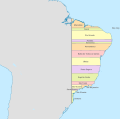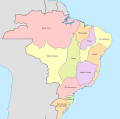Treaty of Madrid (13 January 1750) facts for kids
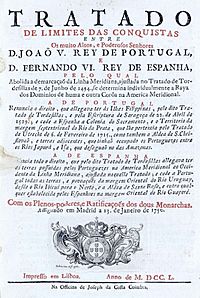
Title page of the Treaty of Madrid (1750)
|
|
| Signed | 13 January 1750 |
|---|---|
| Location | Madrid, Spain |
| Parties | |
| Languages | Spanish Portuguese |
The Treaty of Madrid (also called the Treaty of Limits of the Conquests) was an important agreement. It was signed between Spain and Portugal on January 13, 1750. This treaty aimed to stop many years of fighting in the area that is now Uruguay. It drew clear borders between Portugal's colony, Brazil, and Spain's lands to the south and west.
Portugal also agreed that the Philippines belonged to Spain. In return, Spain accepted that Brazil could expand further west. The treaty also included a promise: if a third country attacked either Spain's or Portugal's colonies in America, the other country would help. This treaty was special because Spain and Portugal decided to ignore older agreements. These older agreements, like the Treaty of Tordesillas, had been set up by the Pope.
Contents
Why was this treaty needed?
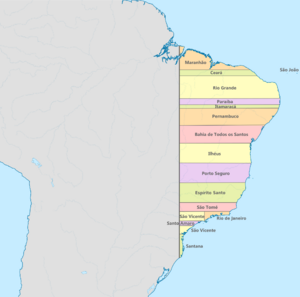
Before this treaty, older agreements like the Treaty of Tordesillas set strict limits. These limits said Portugal's empire in South America could not go further west than a certain line. This line was about 370 leagues (a long distance) west of the Cape Verde Islands.
If these old rules had stayed, Brazil would be much smaller today. Cities like São Paulo and all the land to its west and south would have belonged to Spain.
However, things changed when gold was found in Mato Grosso in 1695. Starting in the 1600s, Portuguese explorers and traders moved west. They came from Maranhao in the north and São Paulo in the south. These groups, called bandeirantes, were looking for gold and slaves. They went far beyond the old treaty line.
Because of this movement, Portugal created new administrative areas. These new areas, like Minas Gerais and Mato Grosso, were beyond Brazil's old borders.
What did each country want?
What did Portugal want?
Portugal wanted to create a fair border between its lands and Spain's. They wanted to keep most of the Amazon basin. They also wanted to make sure they owned the gold and diamond areas of Goias and Mato Grosso.
Portugal also wanted to protect Brazil's border in the south. They hoped to keep the Rio Grande do Sul area. They also wanted to gain control of seven Spanish Jesuit missions. These missions were on the left bank of the Uruguay River. Portugal also wanted to control river routes to Maranhao-Para. This would ensure they could use rivers like the Tocantins and Madeira.
What did Spain want?
Spain wanted to stop Portugal from expanding further west. Portugal had already taken over a lot of land that was supposed to be Spanish. This land was mostly untouched jungle.
Spain also wanted to get the Portuguese colony of Colonia del Sacramento. This colony was a secret way for England and Portugal to trade illegally with Peru. It also made the Spanish city of Buenos Aires unsafe from attacks. Spain also hoped to weaken the alliance between England and Portugal. They wanted to form an alliance with Portugal against England in South America.
What were the terms of the treaty?
The Treaty of Madrid was based on two main ideas. The first was Uti possidetis, ita possideatis. This Latin phrase means "who owns by fact owns by right." It meant that each country would keep the land it already controlled. The second idea was "natural boundaries." This meant that rivers and mountains would be used to draw the borders.
So, the treaty allowed Portugal to keep the lands they had taken from Spain's empire. The treaty also said that Spain would get the Sacramento Colony. In return, Portugal would get the Misiones Orientales. These were seven independent Jesuit missions near the upper Uruguay River. The old Treaty of Tordesillas was officially cancelled.
The treaty tried to use natural features like rivers and mountains for the border. The border moved west from the Atlantic coast, south of Rio Grande do Sul. Then it went north, following parts of several rivers. These included the Uruguay, Iguaçu, Paraná, Paraguay, Guapore, Madeira, and Javari Rivers. North of the Amazon, the border ran from the Negro River to the area between the Amazon and Orinoco rivers. It then followed the Guiana watershed to the Atlantic.
Soon after the treaty was signed, two groups were created. Their job was to mark the new borders. One group worked in the North, and the other in the South.
What happened after the treaty?
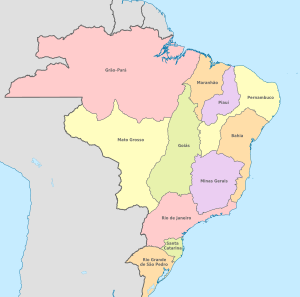
The Treaty of Madrid was very important. It largely set the modern borders of Brazil. However, there were problems. The Jesuits did not want to give up their missions. The Guaraní people refused to be forced to move from their homes.
Because of this resistance, the treaty was cancelled by another agreement in 1761. This new agreement was called the Treaty of El Pardo. The Guaraní people's opposition led to a conflict called the Guaraní War in 1756.
There were often small fights in the Banda Oriental area after the 1750 treaty. But the main ideas of the Treaty of Madrid were brought back in 1777. This happened with the First Treaty of San Ildefonso. However, that treaty was also cancelled later in 1801.
See also
In Spanish: Tratado de Madrid (1750) para niños
Images for kids



